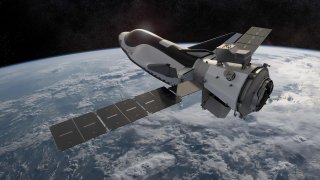
- Sierra Space, the subsidiary of private aerospace contractor Sierra Nevada Corporation, raised $1.4 billion in new capital.
- The company's valuation jumped to $4.5 billion following the raise, with investors including General Atlantic, Coatue, and Moore Strategic Ventures, as well as the funds of private equity firms BlackRock and AE Industrial Partners.
- Sierra Space has two major projects in development: The Dream Chaser spaceplane and the Orbital Reef space station, the latter which it partnered with Jeff Bezos' Blue Origin to build.

Sierra Space, the subsidiary of private aerospace contractor Sierra Nevada Corporation, raised $1.4 billion as the company expands its portfolio of space transportation products.
The company's valuation jumped to $4.5 billion following the raise, with investors including General Atlantic, Coatue, and Moore Strategic Ventures, as well as the private equity funds of BlackRock and AE Industrial Partners.
Get Boston local news, weather forecasts, lifestyle and entertainment stories to your inbox. Sign up for NBC Boston’s newsletters.
Sierra Space has two major projects in development: The Dream Chaser spaceplane, which it is developing to deliver cargo and eventually crew to low Earth orbit, and the Orbital Reef space station, which Sierra Space partnered with Jeff Bezos' Blue Origin to build.
"I envision a day where people are flying up on a Dream Chaser, they're docking to either a hotel or condominium building on orbit, spending three days or five days with their family, and then returning back again to a port of their choosing," Sierra Space CEO Tom Vice told CNBC.
The capital represents the first outside investment in Sierra Space since the subsidiary was set up by Sierra Nevada Corporation in April.
Money Report
The company plans to use about two thirds of the new capital for Dream Chaser, a reusable spacecraft that – in appearance resembling a miniaturized NASA Space Shuttle – is built to launch atop a traditional rocket and land on a runway like an airplane.
Vice emphasized that Dream Chaser is "not a single product" but a family of products. The cargo version is planned to launch to the International Space Station for NASA in fourth quarter 2022, the crewed version is targeting a 2025 debut, and the company is looking at creating a third "specialized" variant to serve for national security missions, potentially similar to how Boeing's X-37 spaceplane is used by the Air Force.
Sierra expects to use the final third of the new funds for its space destination products, like Orbital Reef. Blue Origin is Sierra Space's primary partner for Orbital Reef, with the team also including Boeing, Redwire Space and Genesis Engineering. The companies plan to have Orbital Reef in space and operational by 2027, Vice said, with the habitat designed for up to 10 people at a time.
"Our real focus at Sierra Space is to become the largest real estate developer in space," Vice said.
Vice noted that Sierra looked "all the options" for raising capital, including the possibility of merging with a SPAC (special purpose acquisition company) and going public. But the company decided the best approach was to stay private, with Vice saying Sierra will likely take another look at going public in about two years.






